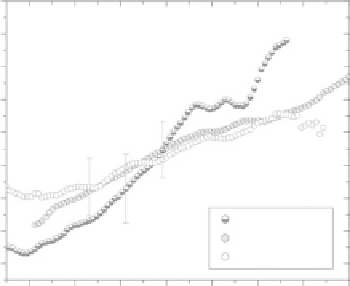Biomedical Engineering Reference
In-Depth Information
TABLE 8.1
Bulk Optical Parameters for Murine Striated Muscle at the Fundamental and SHG Wavelengths
λ
457 nm
890 nm
% Glycerol
Control
25%
50%
75%
Control
25%
50%
75%
g
0.96
0.96
0.96
0.96
0.96
0.96
0.96
0.96
μ
s
(cm
−1
)
509 ± 225
229 ± 71
71 ± 25
28 ± 2.4
285 ± 113
138 ± 45
29 ± 5
26 ± 6
μ
a
(cm
−1
)
9.1 ± 3.1
8.8 ± 1.4
3.8 ± 1.5
3.3 ± 1.2
5.9 ± 1.5
2.9 ± 0.5
1.9 ± 0.5
1.4 ± 0.2
Source:
Reproduced from LaComb, R. et al. 2008.
J. Biomed. Opt
. 13:021108.
of magnitude improvement in tissue transparency. The absorption coefficients also decrease possibly
due to replacement of cytoplasmic proteins, but absorption contribution is already relatively negligible
in the control sample (~10 cm
−1
). Even though the reduced scattering coefficient is twice higher at the
SHG wavelength than the near-IR excitation (890 nm), it is shown in Ref. [6] that the axial attenuation
response is largely dominated by the primary filter effect (since SHG signal scales as the square of the
excitation intensity) rather than scattering and absorption of SHG photons. Figure 8.3c shows the com-
parison between the Monte Carlo simulations using the measured optical parameters and the experi-
mental data for the 25% and 75% treatments. In both cases, good agreement is achieved. This analysis
shows that the extent of clearing can be predicted in an SHG imaging experiment if the bulk optical
properties before and after clearing are known.
The analysis of the experimental and simulated curves of forward-to-backward (
F
/
B
) ratio of SHG
intensities as a function of depth offers additional insight into the optical clearing mechanism. The
detected backward SHG consists of direct quasi-coherent emission and a multiple scattered incoher-
ent component in proportions that depend on local packing of dipoles in SHG-producing domain
and bulk optical properties, respectively [30]. Optical clearing can affect both these attributes. In the
muscle, the whole myofibril (~1-3 μm) is the SHG-producing element, whereas myofibrils stacked
together create an extended SHG-producing domain that is larger than λ
SHG
. Consequently, the ini-
tial SHG emission in the muscle is nearly forward directed. This is demonstrated by the simulations
plotted in Figure 8.4b. Uncleared muscle is one of the most scattering of tissues. If we compare the
(a)
22
(b)
14
22
18
16
12
10
14
12
10
8
Uncleared
25% Glycerol
6
25% Glycerol
8
6
50% Glycerol
50% Glycerol
4
75% Glycerol
75% Glycerol
100
200
300
400
0
50
100
150
200
Depth (µm)
Depth (µm)
FIgurE 8.4
Axial dependence of the forward-to-backward SHG intensity (
F/B
) ratio measured in the muscle
sample cleared in 25%, 50%, and 75% glycerol-PBS solution. The data for the experimental control (uncleared)
sample were in the noise floor, and a meaningful
F/B
ratio could not be ascertained. (a) Experimental data. (b)
Monte Carlo simulation results assuming 100% forward creation directionality. (Reproduced from LaComb, R.
et al. 2008.
J. Biomed. Opt
. 13:021108.)

















